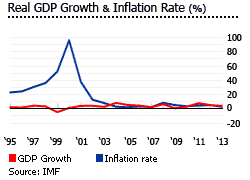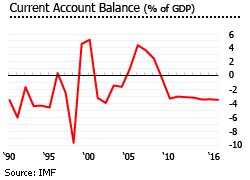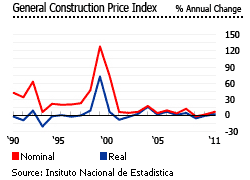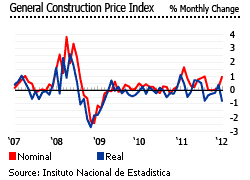Ecuador’s property market is now slowing
After five years of house price increases, Ecuador´s property market is now slowing, partly due to an oversupply of residential properties.
In Quito, the country´s capital city, rich in cultural traditions and architectural heritage, the average prices of apartments and houses was stable in October 2013 from a year earlier, according to the latest research conducted by the Global Property Guide.
In October 2013:
- Apartments located in Quito were priced around US$900-US$1,000 per square metre (sq. m.) or US$80-US$95 per square foot.
- Houses were priced around US$700 to US$820 per sq. m., or US$65 to US$75 per square foot.
In Cuenca, the country´s third largest city and the economic hub of the southern Sierra, house prices continue to rise. Cuenca saw average increase in house prices of about 8% to 12% annually in the past five years, according to Cuenca Real Estate. Newer condominium units even registered house price rises of 10% to 12%. However in 2013 house price increases decelerated to single-digits. In early 2013, the average purchase price of new condos range from US$975 to US$1,250 per square meter (sq. m.).
In early-2013:
- In Cuenca, the average price of new two-bedroom apartments with tile and wood finishings stood between US$75,000 and US$90,000.
- The average price of new three-bedroom apartments with 2-bath unit and spectacular view ranged from US$95,000 to US$120,000.
- In the large home market, a 3,000 to 5,000 square foot houses in Cuenca´s posh neighbourhoods are priced about US$275,000.
Ecuador´s house price rises in the past several years are mainly driven by:
- economic growth, as the country is enjoying a rapid development
- urbanization programs
- increasing flows of migrants returning home
- American expatriates choosing to settle in places such as Quito and Cuenca
- relatively low interest rates
However "We are beginning to see an oversupply of housing for middle- and upper-middle-class buyers," said Roberto Vega, general manager of Smart Research in Quito. "We are seeing this in the more active markets, such as Quito, Guayaquil and Cuenca, although there are other markets where there is still a shortage of housing and good demand."
There were more than 30 large condominium projects under constructionin Cuenca during the first half of 2013, a slowdown from the 40 to 45 projects seen in 2011. In addition, fewer building permits were issued in 2013 compared to the previous year, according to the Cuenca Chamber of Construction.
There has also been a decline in mortgage loans. "In 2010 and 2011, the number of mortgages written by commercial banks increased by 10% and 12% a year. In 2012 the increase was only 2% and it´s possible that we will see a decline in 2013," said Vega.
As of April 2014, the effective lending rate for purchasing dwellings stood at 10.64%, unchanged on the previous two years, according to the Banco Central del Ecuador.
"Overall, I´m optimistic but I am also realistic. The appreciation will go down and it will take longer to sell properties but ultimately this will be good for the market," said Jaime Rumbea, director of the Ecuador Real Estate Association.
Property prices in Ecuador are usually quoted in US dollars. The US dollar has been the official currency of Ecuador since 2000.
Ecuador´s property market is mainly driven by Ecuadorians, both local homebuyers and those returning from the United States and Spain, according to Cuenca Real Estate. In recent years, returning Ecuadorians accounted from about 30% of all local sales while North Americans and Europeans account for just about 1.5%. Foreign buyers usually buy condominiums located near the city centre or just outside the historic district.
The government of Ecuador grants real estate visas to foreigners who purchase homes in the country worth at least US$25,000. In addition, the country also grants pensioners visas to foreigners with retirement income of not less than US$800 per month.
Thriving economy

In 2013, the economy was estimated to have expanded by 4%, from annual average growth rates of 5.1% in 2012, 7.8% in 2011, and 2.9% in 2010, according to the IMF. The economy is expected to grow between 4.5% and 5.1% in 2014, based on government estimates.
Ecuador´s overall inflation rate fell by 2.7% in 2013, far below the inflation rates of 4.16% in 2012 and 5.41% in 2011 and the lowest level in the past eight years, according to the National Institute of Statistics and Censuses (INEC). This is also below the government´s inflation target of 3.93%. In March 2014, the annual inflation rate increased to 3.11%, according to Banco Central del Ecuador.
The average family income in Ecuador reached US$593.60 per month in 2013, with an average of 1.6 earners per household, according to INEC.
In the fourth quarter of 2013, the country´s overall unemployment rate rose to 4.86%, up from 4.6% the previous quarter, according to the Banco Central del Ecuador - far lower than the average unemployment rate of 9.7% from 2000 to 2010, according to the IMF.
As of September 2013, Ecuador´s foreign debt was equivalent to 13.9% of GDP.
People are moving to urban centers.

Since 1990 the urban population has increased at an average annual rate of 2.7%. By 2010, 67% of the population lived in towns.
"Besides construction in Quito and Guayaquil, Cuenca and Manta are also experiencing building booms", says Morrill.
"In the residential market, Ecuadorians returning from overseas, to live or invest, mostly from the U.S. and Spain, are a major factor."
Adds the Ecuadorian architect Dayuma Roman Jauch: "In the last ten years households have had easier access to mortgages to buy flats in urban centers. Also, big firms help to their workers to buy homes close the place of work."
 Not the best place in the world for doing business
Not the best place in the world for doing business
However Ecuador is no Asian Tiger. The Doing Business Report 2012 (World Bank) ranks Ecuador 130 out of 183. In one of indicator, Starting a Business, Ecuador ranks 164. "An entrepreneur in Quito needs to complete 12 procedures, wait 56 days and pay the equivalent of 28.8% of the GNI per capita to start a business" says Alejandro Espinosa-Wang, of the World Bank.
In contrast, "the average number of procedures needed in the Latin American and the Caribbean region is 9. And in the OECD high income economies, only 5. The average time to start a business is 54 days, and 12 days, respectively."

The political landscape is turbulent...
President Rafael Correa, an economist educated in the US, likes to define Ecuador as an anti-Imperialist country and to define its politics as "revolutionary".
Yet despite Correa´s personal friendship with Hugo Chavez, and some tensions with the US over economic policy, Correa´s foreign policy is less confrontational than Venezuela´s.
At home, Correa´s political strategy draws on a mixture of Latin social democratic tradition, and an autocratic left-wing political attitude. So one can see him taking initiatives to protect the environment or promote social housing as well as shaking hands to Iran´s diplomats. The government has taken measures to tackle poverty and inequality, for example increasing the share of oil revenues used for pro-poor spending programs.
Relationships with the media are an issue. Correa´s clashes with the national press have attracted international criticism. An example is the recently passed law that bans the media from directly or indirectly promoting candidates, or electoral preferences, or a political thesis.
Even if the political landscape raises concerns, the visitor who travels around the country can easily see that new roads have been completed, and public schools on the country´s periphery have been spruced up. Like many other Latin American countries, with all its contradictions, Ecuador is developing.
Cuenca and Quito are nice places live in
Ecuador is emerging as a haven for expatriates, especially Americans. Climate, breath-taking landscape and relatively low housing and living costs are the main reasons. Ecuador seems to offer an attractive mix of exoticism and services of good quality.
Cuenca, surrounded by green valleys, this colonial town has cobblestone streets, cathedrals, colonial parks and urban rivers. A city of 330,000 and a Unesco world heritage site, is home to about 5000 US citizens. Since 2009, International Living, a publishing company, has named Ecuador the world´s number 1 retirement country and Cuenca the number 1 retirement city.
Cuenca´s expatriate community has grown by about 4 times in three years. However, real estate sales to foreign pensioners represent only 1% of total sales. By contrast, sales to Ecuadorians returning from overseas account for more than 30% of the total. Returning Ecuadorians are a major factor in price increase, particularly in the condominium market.
In addition to Cuenca, foreigners also look at properties in Manta, Salinas and Quito and the small towns of Cotacachi and Vilcabamba.
Quito has one of the better-preserved colonial towns in Latin America and in 1978 UNESCO declared Old Quito a World Heritage site.
The Andean Cotacachi and Vilcabamba are interesting alternatives to the fashionable Cuenca. Cotacachi is located in a beautiful green valley between two volcanic peaks close to the Pan-American Highway.
Vilcabamba, in the south, is blessed by an enduring spring and a temperature ranging from 19 to 25 degrees. Curiously, it has been studied for the surprising longevity of its 5000 inhabitants.
A completely different atmosphere can be found in Manta or in Salinas. These touristic coastal cities are located on the so-called Routa del Sol and are experiencing a construction boom.
The risk of over-exploiting coastlines
In Ecuador there are miles of empty beaches, with a broad range of climates and natural diversity. However, in absence of a proper regulation, the rapid development of real estate projects might seriously endanger the environment.
Hundreds of households of the emerging middle-class move from the Andean region to the beaches of city such as Tonsupa or Atacames for holidays. But the skyline on the coast is changing fast and the quality of projects is questionable.
"My impression is that - with the exception of natural reserves - proper regulation of building standards on the coastlines is totally missing," says Roman. "All efforts to safeguard the environment seem focused on Amazonia. Ecuador policy-makers need to develop better regulation for the property market on the sea".
Conclusion
Ecuador´s housing market benefits from a booming economy. Large urbanization programs are ongoing. The country is beautiful and attractive. Politics is a risk, as political instability could negatively affect the economy.